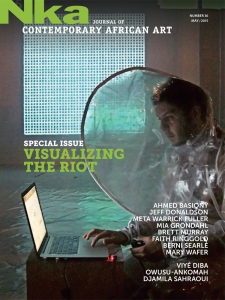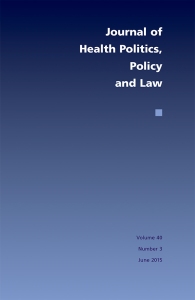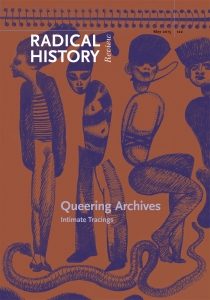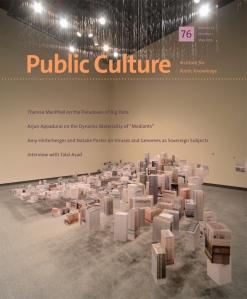We spoke with several Managing Editors to gain more knowledge about publishing academic articles as part of our series on journals publishing. Read on to learn about their processes and how their journals operate. Thank you to managing editors Tom Harbison (Radical History Review), Stephen Twilley (Public Culture), Heather Mallory (Journal of Health Politics, Policy and Law), Jennifer Savran Kelly (Nka), and Michael Cornett (Journal of Medieval and Early Modern Studies) for their great insight into the publishing process!
What criteria do you use to determine if an article is relevant to your journal?
Michael (JMEMS): An editor can usually tell within three pages of reading a submission whether it is relevant to the journal’s interests, and sometimes even sooner, when, for example, the cover letter betrays a lack of awareness about the journal (it is addressed to someone who is not the current editor or “to whom it may concern”; it describes the article in a couple sentences revealing that the topic is not germane; it indicates that the submission guidelines have not been followed in some way). A good journal has a recognizable identity that is caringly cultivated and a preferred procedure for submission, which are made clear in its published mission statement and submission guidelines. Submitting an article without being thoroughly familiar with a journal is like cold-calling on the phone trying to sell something. It’s a good idea for an author to use the cover letter to demonstrate a clear familiarity with the journal—you want the editor to think, “Ah, someone who knows us, I look forward to reading this.”
 Jennifer: Nka covers contemporary African art from the diaspora, including visual art, performance art, film, and any hybrid genre that includes at least one of those aspects. We also review books on contemporary African art. We tend to focus on issues of social justice and are always interested in articles both by and about scholars and artists who are underrepresented in the field.
Jennifer: Nka covers contemporary African art from the diaspora, including visual art, performance art, film, and any hybrid genre that includes at least one of those aspects. We also review books on contemporary African art. We tend to focus on issues of social justice and are always interested in articles both by and about scholars and artists who are underrepresented in the field.
Tom: All issues of Radical History Review (RHR) are organized around a theme, which is clearly defined in the call for proposals. The CFP is crafted by the issue editors, with feedback and approval coming from the editorial collective. During this process, the collective places a high priority on checking that a new CFP adheres to the scholarly mission of the journal. The CFP initiates the process of gathering submissions. We only consider abstract submissions that pertain to particular CFPs. After the issue editors decide which pieces to pursue full-length submissions for, they oftentimes make requests to the authors to steer in a certain direction as they compose the full-length submission. This allows the issue editors to start shaping the issue and tie back to the goals set out in the CFP.
What is the submission process like for your journal?
Jennifer (Nka): Authors are asked to submit full articles, along with high-resolution images, captions, and reproduction permission. We also ask for an abstract. When articles are submitted in full, it makes our process go more smoothly, both for our editorial office and our contributors. Recently, we moved submissions away from postal mail and e-mail in favor of the online submission manager Submittable. Our editors endeavor to respond within a few months of submission.
 Heather: The Journal of Health Politics, Policy and Law guidelines are available on our Duke University Press website along with a link to Editorial Manager (our online submissions tracking system). The journal asks that all authors submit their articles through Editorial Manager. Authors are in contact with the editorial office throughout the peer-review process. Once the articles is accepted and has been revised to the academic editor’s satisfaction, the article is then passed on to the managing editor at Duke University Press.
Heather: The Journal of Health Politics, Policy and Law guidelines are available on our Duke University Press website along with a link to Editorial Manager (our online submissions tracking system). The journal asks that all authors submit their articles through Editorial Manager. Authors are in contact with the editorial office throughout the peer-review process. Once the articles is accepted and has been revised to the academic editor’s satisfaction, the article is then passed on to the managing editor at Duke University Press.
Stephen: The process for submitting to Public Culture has become very simple, thanks in large part to our recent move from a customizable but fairly clunky online database to a purpose-built web application called Submittable (it doesn’t do everything we’d like, but what it does it does well). Interested authors can find complete submission guidelines on our website; once they’re ready to submit, they can upload all materials there; they receive an automated confirmation e-mail with information about approximate timelines and whom to contact with any questions.
Tom (RHR): For each issue, we first publish a call for proposals. The issue editors then invite a subset of the authors to submit full-length submissions. All of the submissions get sent first to the editorial office, where they are filed in a location accessible to the issue editors and cataloged in a spreadsheet. After full-length submissions are received, the issue editors initiate the peer review process by identifying at least one internal and one external reader for each piece under consideration.
What are you looking for in a manuscript when you receive it?
 Michael: Bottom line, at the Journal of Medieval and Early Modern Studies, we look for an article that is relevant to our aims, that will appeal to our broad, cross-disciplinary audience. But the ones we accept for publication also possess a timely sense of scholarly intervention in a compelling debate. And well-written articles with style and verve impress far more than plodding, stodgy prose.
Michael: Bottom line, at the Journal of Medieval and Early Modern Studies, we look for an article that is relevant to our aims, that will appeal to our broad, cross-disciplinary audience. But the ones we accept for publication also possess a timely sense of scholarly intervention in a compelling debate. And well-written articles with style and verve impress far more than plodding, stodgy prose.
Heather (JHPPL): Since the article has already gone through the peer-review process, been accepted, and revised by the time it reaches me, I am looking to be sure the article is in good shape to put into production. Specifically, I’ll want to make sure that all the essential elements are present: article title; author’s or authors’ name(s), bios, and affiliations; abstract; keywords; figure/table captions, permissions, sources, notes; references. Once I verify that I have all these elements, I’m looking to make sure that they correspond with our journal’s style.
Tom (RHR): We detail the expectations in the call for abstracts, and then again in the invitation e-mails that go to authors. In addition to monographic historical pieces, we encourage non-traditional formats such as reflection essays and reviews, and we welcome submissions from artist, activists, and those working outside of academia.
What is the peer review process like?
 Tom: Before acceptance for publication in RHR, any research article must go through peer review with at least one internal and one external reader. An internal reader is typically a member of our editorial collective and someone with an intimate knowledge of the journal. An external reader is a scholar with subject area expertise in the topic of the article under review.
Tom: Before acceptance for publication in RHR, any research article must go through peer review with at least one internal and one external reader. An internal reader is typically a member of our editorial collective and someone with an intimate knowledge of the journal. An external reader is a scholar with subject area expertise in the topic of the article under review.
Michael (JMEMS): Editors do not want to waste the precious resource of specialist reviewers (very busy people who are asked to work for free on the editor’s schedule!), so submissions that manifestly do not have a chance of being published for various reasons are weeded out during the editors’ desk review. We try to offer constructive comments to authors even at this stage, believing we have some responsibility to help aspiring authors learn how to publish. Having passed the first level of review, a submission then goes to a board member or other associate reviewer with broad expertise on the topic. If the article impresses at this stage, it finally goes on to external, specialist review for a detailed critique that we expect to be valuable to the author. If we invite an author to revise a manuscript based on the external review, we try to stick with the same reviewer for evaluating the revision. We apprise authors at each stage of review, letting them know what to expect next. Depending on how far a submission advances through the review process, vetting can take from a few weeks to six months, or longer when revision is invited.
Heather (JHPPL): The editorial office handles the peer-review process before the articles reach me. In our journal the research articles are peer-reviewed, but the special sections are reviewed by the special section editors and are reviewed (or not) at that editor’s discretion. For research articles, authors submit through Editorial Manager, which alerts the assistant editor that an article is ready to be reviewed. The assistant editor and the academic editor decide who should review the article and select three different reviewers to review the piece. The academic editor looks over all three reviewers’ comments and recommendations (accept, accept with revisions, reject). The authors then work with the academic editor if revisions are necessary. Authors are given a final answer generally within 90 days of submission.
Stephen (PC): Once we’ve determined that a particular submission merits a peer review, we generally write to three scholars working on topics related to the submission, with an eye toward a diversity of disciplinary competences, requesting comments within three weeks if possible. If a potential reviewer declines (because of travel or fieldwork or other scheduling challenges, because of a conflict of interest or perceived lack of fit, or simply because he or she is overwhelmed with similar requests or other responsibilities), we proceed to ask additional scholars until we get at least three commitments. What we’re looking to receive from each is 1–3 pages of frank assessment of whether the research appears original and important, what extent it is in conversation with the relevant scholarship, whether it is well-argued, and whether readers outside of any one discipline would find the text compelling and legible (of course, some deficiency in these areas might be improved in revisions, and we welcome suggestions). Once we have received the reviews (at least two; if the third is repeatedly delayed, we may move ahead rather than oblige the author to wait), the editor, often along with members of the editorial committee, will consult the reviews to decide whether to accept the submission outright (rare), accept with suggestions for revisions, accept pending revisions, invite the author(s) to revise and resubmit, or reject. Guidance on revisions is generally provided by an edited selection of the reviews received; the authors of the original reviews remain anonymous. This is all generally accomplished within three months of submission, but exceptions do occur—academics live complicated lives!
After peer review and acceptance, what can an author expect from the journal?
Tom (RHR): The office will be in touch right away to work out details such as adherence to journal style and collection of supporting materials such as a publication agreement, biographical note, contact information, and, if applicable, permissions for reprinting images or epigraphs. After the piece is copy edited and page set by Duke University Press, authors can expect to receive their piece for review.
Michael (JMEMS): Once we accept an article for publication, the author will receive a formal acceptance letter and a publication agreement (that is the legal, defining moment of “acceptance”). But the editorial process is not over. Accepted articles are then edited in very fine detail, sentence by sentence, to strengthen the precision, clarity, and style of the writing, to ensure accuracy in citing and documenting sources, and to conform the manuscript to the journal’s style guide. The extensive collaboration of several editors and reviewers on a manuscript is what defines the essential value of publishing with an academic press.
Heather (JHPPL): Once the article has been accepted, it is assigned to a specific issue of the journal. The journal’s assistant editor is the primary point of contact for authors until the issue is delivered to Duke University Press. At that point the managing editor becomes the primary point of contact for the author. As managing editor, I prepare the manuscript for the copyeditor and send the copyedits to the authors for review (authors receive a clean file, where the copyeditor’s corrections have been accepted, and a tracked file, where the corrections are tracked and clearly visible to the authors). At that stage authors are given an opportunity to review the manuscript and send back any corrections they would like to make—either to the article or to the suggested copyedits. I communicate with the authors through this process and then send the manuscripts to be typeset. Once the article is typeset, authors can expect to review the files one more time to verify that the article (and figures or tables) meets with approval. Authors are notified when their articles are available online (as Publish ahead of Print). Authors also receive an e-mail from Journals Marketing with information about how to publicize their articles. When authors write me and ask me to work with their universities’ communication offices to coordinate release information, I am always happy to try to accommodate those requests. We also help with press releases and social media requests for tweets, Facebook posts, etc.
 Stephen (PC): Essays accepted for publication will generally be published within 9–12 months of notification. This schedule is somewhat flexible, however, and subject to various contingencies. To start, we ask authors to send us various material that we’ll need in order to submit their essays to the journal’s publisher, Duke University Press, including a publication agreement, abstract, bio, keywords, high-resolution images, permissions documentation, contact info and travel plans, and so on. On a case-by-case basis, I may also work with the author on a line edit of the essay at this stage. Once we’ve gathered and properly formatted all the required material for an issue and sent it on to the publisher, the authors will next hear from me approximately six weeks later, once I’ve received the copyedited issue back from Duke. I immediately send out the copyedited essays and related material to their respective authors, along with detailed instructions on how to review copyedits, answer copyeditor’s queries, and communicate to me any corrections or queries of their own they might have. After following up with the authors to make sure I’ve understood their wishes and obtained approval for any alternative solutions I might suggest, I’ll gather and format all the correction requests and queries in one document for the copyeditor. Approximately four months after sending the raw issue to the publisher, I’ll receive page proofs to pass on to the authors. These show what the essay will actually look like in the journal and include images. Once again I’ll work up a list of author corrections and questions to send back to Duke. In these stages I’m acting both as an advocate for the authors and, in partnership with the publisher, a steward of the journal’s style and reputation. When the actual journal issue appears in print and online some nine months after being sent to Duke, everyone involved has something to be very proud of.
Stephen (PC): Essays accepted for publication will generally be published within 9–12 months of notification. This schedule is somewhat flexible, however, and subject to various contingencies. To start, we ask authors to send us various material that we’ll need in order to submit their essays to the journal’s publisher, Duke University Press, including a publication agreement, abstract, bio, keywords, high-resolution images, permissions documentation, contact info and travel plans, and so on. On a case-by-case basis, I may also work with the author on a line edit of the essay at this stage. Once we’ve gathered and properly formatted all the required material for an issue and sent it on to the publisher, the authors will next hear from me approximately six weeks later, once I’ve received the copyedited issue back from Duke. I immediately send out the copyedited essays and related material to their respective authors, along with detailed instructions on how to review copyedits, answer copyeditor’s queries, and communicate to me any corrections or queries of their own they might have. After following up with the authors to make sure I’ve understood their wishes and obtained approval for any alternative solutions I might suggest, I’ll gather and format all the correction requests and queries in one document for the copyeditor. Approximately four months after sending the raw issue to the publisher, I’ll receive page proofs to pass on to the authors. These show what the essay will actually look like in the journal and include images. Once again I’ll work up a list of author corrections and questions to send back to Duke. In these stages I’m acting both as an advocate for the authors and, in partnership with the publisher, a steward of the journal’s style and reputation. When the actual journal issue appears in print and online some nine months after being sent to Duke, everyone involved has something to be very proud of.
Interested in learning more about journals publishing? Follow along with our Journals Publishing Series or follow our blog to get notifications directly in your inbox when a new post is published.

One comment